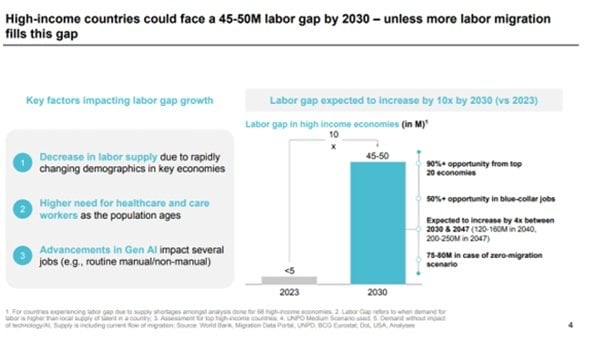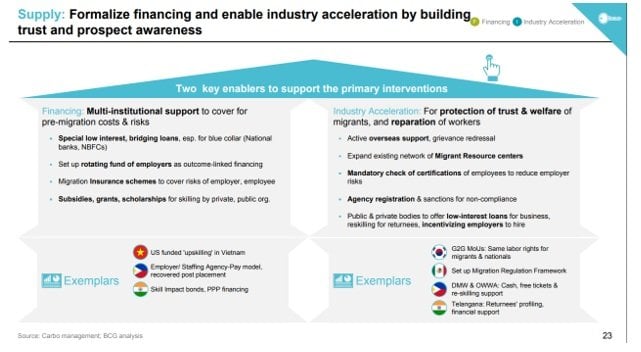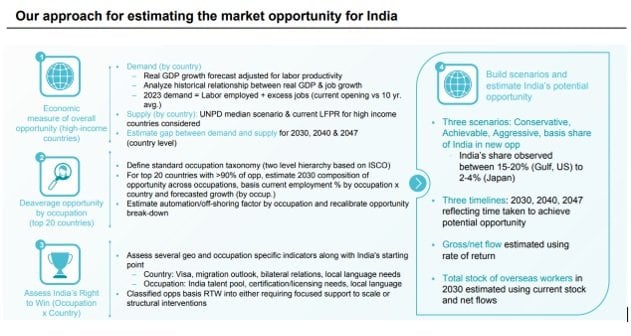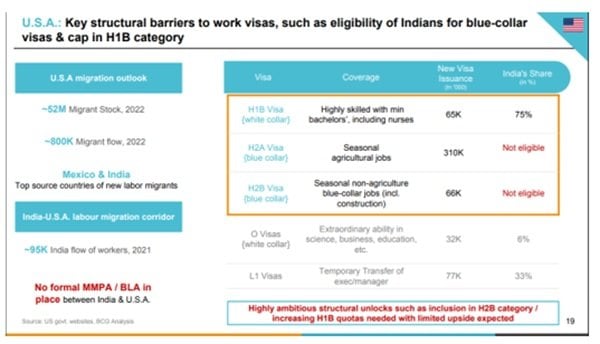
It’s no secret that massive layoffs are currently devastating American workers. While industries across the spectrum are affected, from retail to manufacturing, the hardest-hit area is America’s tech sector, with companies from Amazon to Microsoft to Meta cutting hundreds of thousands of jobs – over 23,400 tech jobs cut in April alone.
While automation and AI are conveniently blamed, hardcore reality comes into view when companies routinely cite “cost-cutting” and “corporate restructuring” – phrases that are often euphemisms for laying off American workers while hiring more foreign workers at lower wages.
At the same time, the government of India is openly celebrating the launch of its latest scheme to supercharge the export of Indian workers to the U.S. and other “high-income economies.” Its goal is to facilitate the global mobility and employment of millions of migrant Indian workers directly at the expense of jobs for Americans.
Not just immigration, but a global labor-export campaign
India’s “Global Access to Talent from India” initiative, or GATI, launched May 6, was personally championed by India’s External Affairs Minister S. Jaishankar and other officials who essentially describe it as a once-in-a-generation opportunity to redirect jobs, wages and even long-term industry trends away from Americans and into the pockets of India’s government, its outsourcing giants and their international partners.
Calling this a “now or never” moment, India warns that the window of demographic advantage could close as competition mounts from African nations, the Philippines, Indonesia, Egypt, Vietnam and Brazil, all vying for their own share of the global labor market.

Referring to a November 2024 think-tank report by two India-based entities, which projects a “global labor gap” of 45-50 million jobs in high-income countries by 2030, GATI sees a huge opportunity to flood foreign markets with its mass population to enter the global workforce. The document outlines a goal of doubling or even tripling the annual outflow of Indian workers, aiming for a “potential stock” of millions of Indian migrant workers overseas.
But the ambition doesn’t end there. India is positioning itself as a “geostrategic partner” for major economies, hoping to be recognized as the world’s “trusted migration partner” and rebranding its citizens as a global “talent brand.” GATI predicts this “talent gap” could expand dramatically over the next two decades.
Behind this bold new push, India has developed a structured and aggressive multi-horizon strategy to unlock its overseas labor potential. Through a combination of diaspora influence, bilateral negotiations, demand-side positioning, skill alignment and financing mechanisms, India calls for a “whole-of-nation” effort to coordinate the mass movement of workers abroad, treating its citizens as a strategic export. At the same time, Jaishankar demands that destination countries eliminate their own protections and reshape their laws to accommodate this outflow.
This is not about mutual benefit, but about using foreign labor markets to solve India’s unemployment and economic growth crises.
Outbound movement, remittance inflow
Thus, by its own admission, GATI has engineered a massive, state-backed campaign to export Indian labor on a scale never before seen. This isn’t just about creating new job opportunities for Indians, it’s about systematically opening foreign markets, expanding India’s labor supply and building a permanent ecosystem that channels workers – and wages – out of America and into India. According to a leader of one of the report’s contributors, the India-based Boston Consulting Group, India’s labor exports could grow to as many as 2.5 million workers per year.
Reality check: This is not a workforce solution for the United States. Indian officials publicly celebrate the higher wages their workers earn overseas, calling it “transformative” for India’s economy, while U.S. companies line up to replace Americans with cheaper, more compliant foreign labor. The result is a hollowing out of America’s middle class, not a win-win for both countries. What’s unfolding in America is not an isolated series of layoffs, but rather a deliberate, top-down overhaul of the U.S. labor market, designed by Indian policymakers, embraced by corporate America and propelled by relentless lobbying for ever more visas.
In fact, the GATI Foundation openly targets $300 billion in annual remittances, money siphoned from American paychecks and communities, to be spent and invested back in India. India’s leaders make no secret of their endgame to use public-private partnerships to streamline recruitment, training and job placement for Indian nationals, maximizing remittance flows and strengthening India’s economic influence abroad.
These remittance inflows have become a critical pillar of India’s economic strategy, pumping billions back into the country every year. Through GATI, India now aggressively markets itself as the world’s “reliable labor supplier,” positioning outbound migration as a strategic national asset.
Unfortunately, the true impact of all this is that every job handed to an Indian guest worker is one lost to an American family. Through the GATI Foundation’s deep network of corporate partners, India is lobbying for looser visa rules and making Indian worker preference the “new normal” in major U.S. industries. Meanwhile, American companies are increasingly outsourcing everything from recruitment to training directly to Indian partners, ensuring that foreign nationals fill key roles while qualified U.S. citizens are left behind.
Thus, at its core, the GATI Foundation’s blueprint is not about helping Americans or remedying genuine labor shortages, but about exploiting loopholes in U.S. immigration policy and leveraging global labor narratives to cement India’s rise, at the direct expense of the American workforce.
The real agenda behind ‘Global Talent Shortage’
The GATI Foundation was created to exploit what India calls a “demand-supply mismatch” in global labor markets. Citing projections that labor shortages in high-income countries could reach 250 million in 25 years, India pitches itself as the answer, if only Western nations open their doors to millions of Indian workers. The GATI Report frames this supposed crisis as an economic certainty, pushing the narrative that countries like the U.S. and Europe must ramp up labor migration or face disaster.
But this narrative falls apart on closer inspection.
These “shortage” projections ignore millions of Americans and Westerners who have been forced out of the workforce by layoffs, offshoring and corporate cost-cutting. The “labor gap” is little more than an accounting trick, counting open positions that employers refuse to fill at fair wages and normal working conditions. Instead of investing in local workers, companies push for visas to import cheaper labor. And India stands ready to supply it.

The contradiction is glaring: GATI and its supporters claim automation and “Gen AI” are both eliminating jobs and creating labor shortages at the same time. It’s a manufactured crisis, a narrative designed to benefit global corporations and foreign governments, but not American families.
In truth, India’s campaign isn’t about filling genuine labor gaps, but about lobbying for new visa categories, higher caps and direct government-to-government deals to force open “mature” markets like the U.S., UK, Canada, Germany and Japan. The GATI Report itself concedes that in these countries, mass inflows are possible only if their governments change laws and visa policies – not because the market demands it, but because India’s lobby demands it.
After all, if there truly were a dire worker shortage, existing visa programs would be flooded with qualified applicants and positions would fill quickly. Instead, India is manufacturing demand by lobbying for new pathways and is using its diplomatic muscle to export its unemployment crisis and the “remittance gold rush” that comes with it, into Western economies.
As detailed in India’s own 2024 Employment Report, India’s job creation is not keeping pace with its exploding youth population. Far from being a demographic advantage, this so-called dividend is a growing liability, with millions of educated young Indians unable to find work at home.
But Jaishankar and the rest of India’s leadership are not merely describing labor trends; they’re demanding permanent, government-backed pipelines to move Indian workers into foreign markets, shifting the costs and consequences onto the United States and its citizens. The so-called “global talent shortage” is not a fact of economics, but a tool of policy – propaganda crafted to dismantle labor protections, depress American wages and entrench the power of foreign governments and multinationals, all at the expense of the American worker.
The skills mirage: India’s talent shortage cover-up
India promotes its vast, English-speaking workforce as the solution to the so-called global talent shortage, marketing the GATI scheme as a direct pipeline of world-class professionals. In truth, GATI is engineered to move as many people abroad as possible, papering over the persistent problems of quality, skills and employability that continue to plague India’s workforce. Leaders like Jaishankar champion “skill development” and “global mobility,” but India’s own data reveals the reality: Fewer than half of Indian postgraduates are employable by international standards, according to India’s Skill Reports. This isn’t about quality; it’s about numbers.
Thus, billions are funneled into crash courses, language bootcamps and certifications, not to build genuine expertise, but to create a façade of qualification, often after jobs have already been promised overseas. Even in crucial sectors like healthcare, where Jaishankar boasts India can “solve” Western shortages, the fact remains: India struggles to meet its own domestic needs. Skill reports and experts like Dr. Lekha Chakraborty confirm that Indian training programs consistently fail to prepare graduates for real-world demands, leaving millions underserved and resources misallocated. Yet, rather than closing the skill gaps at home, the focus is on exporting as many workers as possible, regardless of whether they actually meet international standards.
The reality is, India isn’t overflowing with world-class professionals; it’s overflowing with people. Thus, the Indian government’s real objective is to wedge as many Indian nationals as possible into good-paying American jobs, often regardless of true qualification or the local impact. Meanwhile, capable American workers are left behind, not due to a lack of ability, but because U.S. policymakers and corporations have bought into India’s narrative and abandoned investment in the American workforce.
The hidden cost of investing in India’s labor-supply strategy

India has built a vast financial infrastructure to facilitate outbound migration, offering bridging loans, insurance and rotating funds, all subsidized by public and private grants. For employers, it’s cheaper to bring in Indian nationals than to invest in their own workforce.
But the GATI strategy doesn’t stop at financing. India is demanding that host countries overhaul their own labor systems to accommodate and protect incoming foreign workers. Grievance mechanisms, legal mandates and resource centers lock in rights for migrants, while incentives including low-interest business loans and reskilling support are used to tilt hiring toward foreign workers.
The hidden costs are staggering. American workers are not only undercut by lower-paid foreign labor, but are forced to compete with a workforce backed by another nation’s government and a web of corporate allies. Meanwhile, U.S. training standards and credential requirements are undermined, eroding the value of American education and experience.
This isn’t a temporary fix. It is a permanent, self-reinforcing system, channeling billions of dollars in remittances to India and institutionalizing foreign-worker preference in advanced economies. The outcome is inevitable: falling wages, lost jobs and a steady erosion of America’s sovereignty over its own workforce. Every dollar invested in this supply strategy is a dollar stolen from the American economy. It’s time to demand a course correction, one that puts American skills, livelihoods and interests first.
Hiring from India is like signing a contract riddled with hidden clauses; by the time the consequences are clear, the damage is done. The American workforce deserves better. Those jobs belong to American workers, not a foreign government’s export strategy.
A blueprint for displacement: India’s cold, calculated framework


India’s own analysis admits Indian certifications often aren’t recognized overseas due to mismatched skill requirements and quality standards – a clear sign that many of the workers being pushed abroad are not actually qualified for the jobs at hand.
To get around these constraints, India’s plan is to “harmonize demand-centric skilling,” lobbying for international recognition of Indian credentials and pushing for government-backed loans to subsidize outbound migration. The goal isn’t to meet genuine needs, but to bypass local standards and flood foreign markets, regardless of the consequences for host countries.


Every time a visa barrier is lowered or a new guest worker program is launched, it opens the door for India to embed even more of its surplus labor in Western economies. But the ambitions don’t stop with white-collar tech jobs. India’s leaders are playing a much longer and more aggressive game, openly targeting blue-collar visa categories like H-2A and H-2B, sectors that have long provided stability for American families and local communities.
Their policy documents make this crystal clear: India’s strategy is to steadily lobby for the removal of visa caps, to institutionalize so-called “circular migration” so Indian workers can cycle through U.S. jobs indefinitely and to push for changes in immigration law that make Indian labor the default option for both high- and low-skill roles. This is not a temporary workforce solution; it’s a step-by-step plan to permanently transform the American labor market in ways that serve India’s interests while sidelining American workers at every level.

America’s future: At a crossroads
Bottom line: As American companies outsource everything from recruitment to onboarding to Indian partners, foreign nationals are funneled into critical roles across tech, healthcare, engineering and more, frequently at the direct expense of U.S. citizens. Accreditation standards are diluted. Worker protections are eroded. The playing field is tilted.
India’s GATI initiative does not represent an invitation for partnership; it serves as a stark warning. As Indian leaders openly coordinate, lobby and strategize to gain a foothold in U.S. job markets, too many American officials remain silent or, worse, actively complicit. Every so-called “strategic migration partnership” and each new visa pipeline laid is another brick in the wall separating American families from their own economic future.
The stakes could not be higher. This is not a tale of isolated layoffs or routine workforce shifts, but a deliberate, foreign-led transformation of the U.S. labor market. It is sold as progress but experienced as loss in every community facing layoffs, stagnant wages and vanishing careers. Each time an American worker is replaced by a lower-paid Indian “guest worker,” it marks another victory for India’s national agenda and another defeat for the American middle class.
Unless action is taken, this pattern will only accelerate. American laws, corporations and policymakers risk becoming tools for India’s economic ascent while the American dream is steadily outsourced and rewritten. Americans must demand that their leaders defend their interests by rejecting foreign lobbying, putting an end to corporate collusion that enables mass visa fraud and restoring a workforce system that prioritizes American citizens in their own country.
The choice is clear. Either the United States reclaims its labor market, its laws and its future, or the nation will continue down a path where its greatest export is its own prosperity. History will not be kind to those who allowed this nation to be given away. Now is the time to draw the line: America first, in every job, every industry, and every decision. Otherwise, America’s children will no longer compete with the “world” for the American dream – because that dream will belong to India.
Editor’s note: This story is one of the most important currently facing Americans – yet outside of WND, it is almost entirely unreported. For years, WND has warned about the dangers of unchecked immigration and global labor schemes. Now, in real time, Americans are witnessing a foreign government making its final, strategic move to overtake their nation, one visa at a time.
WND cannot win this battle alone. With your voice, support and vigilance, we can make sure America’s future is decided by Americans, not by foreign interests. Follow us, share this investigation and join the fight to keep America first.







